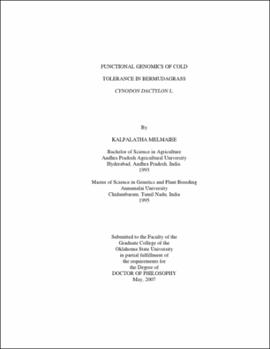| dc.contributor.advisor | Anderson, Michael P. | |
| dc.contributor.author | Melmaiee, Kalpalatha | |
| dc.date.accessioned | 2013-12-10T18:04:36Z | |
| dc.date.available | 2013-12-10T18:04:36Z | |
| dc.date.issued | 2007-05 | |
| dc.identifier.uri | https://hdl.handle.net/11244/7738 | |
| dc.description.abstract | Scope and Method of Study: Bermudagrass (Cynodon dactylon L pers.) is one of the most widely adapted warm-season grasses with its usage and geographic distribution limited by cold temperature. The goal of this research was to identify genes that are differentially expressed during cold acclimation in two bermudagrass genotypes (MSU and Zebra) that differ in tolerance to low temperature stress. Microarray analysis was performed to study gene expression at global level. | |
| dc.description.abstract | Findings and Conclusions: In this study, we were able to identify 566 differentially expressed genes from tissues of MSU and Zebra bermudagrasses. These genes associated with metabolism, signal transduction, dormancy regulation, and senescence related functions. UBA/THIF-type NAD/FAD binding protein, sucrose synthase2, cysteine protease14, putative cystatin , predicted seven transmembrane receptor, actin, ADPribosylation factor, DELLA protein GAI1, ribosomal protein, Cytochrome P450 like _TBP were identified as genes associated with cold acclimation. Genes involved in kinase signal cascade (MAPKKK, MK5, SERK2 protein precursor) and in metabolism (sucrose synthase2, ACBP, aspartate aminotransferase) were identified as associated with cold tolerance as they were up-regulated only in cold tolerant MSU during cold acclimation period. Because cold tolerance involves cross talk between multiple pathways, characterizing these genes along with highly induced genes of unknown function may help us better understand their role in cold tolerance. This study constitutes the first large-scale analysis of gene expression pathways during cold acclimation in bermudagrass. Results from this study will serve as a basis for further investigations into the cold acclimation and tolerance mechanisms associated with bermudagrass stress response. | |
| dc.format | application/pdf | |
| dc.language | en_US | |
| dc.rights | Copyright is held by the author who has granted the Oklahoma State University Library the non-exclusive right to share this material in its institutional repository. Contact Digital Library Services at lib-dls@okstate.edu or 405-744-9161 for the permission policy on the use, reproduction or distribution of this material. | |
| dc.title | Functional genomics of cold tolerance in bermudagrass Cynodon dactylon L. | |
| dc.contributor.committeeMember | Guenzi, Arron C. | |
| dc.contributor.committeeMember | Taliaferro, C. M. | |
| dc.contributor.committeeMember | Anderson, Jeffrey | |
| osu.filename | Melmaiee_okstate_0664D_2171 | |
| osu.accesstype | Open Access | |
| dc.type.genre | Dissertation | |
| dc.type.material | Text | |
| dc.subject.keywords | bermudagrass | |
| dc.subject.keywords | cold acclimation | |
| dc.subject.keywords | microarray | |
| dc.subject.keywords | ssh | |
| thesis.degree.discipline | Plant Science | |
| thesis.degree.grantor | Oklahoma State University | |
